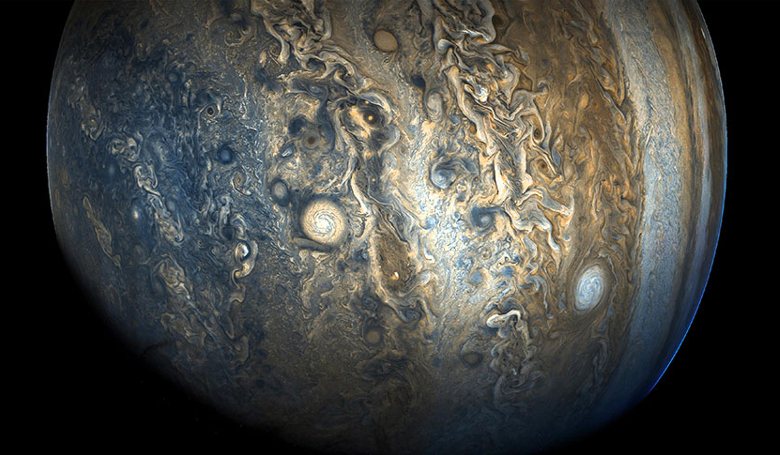The banded stripes circling Jupiter have fascinated people as much as the Great Red Spot, ever since Galileo first spotted the gas giant. Now, thanks to data collected by the Juno mission, scientists have been able to take a ‘peek’ beneath the planet’s surface to see just how far these belts of strong winds extend; and its far, very far.
Before Juno reached its target in 2016, it was not known whether the colourful bands wrapped around Jupiter were just a pretty surface phenomenon, or whether they were enormous deep layers penetrating down into the abyss below. It turns out, they are the latter.
Like the Great Red Spot, the wind belts have persisted for hundreds of years and they are strong – much stronger than the fiercest winds on Earth, but ironically it is the flow of these bands that run from both east to west and west to east that have helped scientists measure how deep they go.
As these ferocious winds relentlessly circle the planet, they disrupt the even distribution of mass on the planet. By measuring this imbalance, which represents a change in the planet's gravity field, scientists have been able to establish that the winds reach a depth of around 3,000 kilometres; quite a bit more than previous estimates had calculated.
"Since Jupiter is basically a giant ball of gas, the initial expectation was that there would be no asymmetries in the gravity field between the north and south,” said Professor Yohai Kaspi from The Weizmann Institute in Israel and lead author of the research paper recently submitted to Nature.
However, assumptions changed and Kaspi calculated that an imbalance due to the winds in the north and the south should indeed produce a measurable gravitational signal. This was confirmed by measurements taken with Juno after the spacecraft arrived at the gas giant.
The calculations also show that Jupiter's atmosphere makes up 1% of its total mass. Although this doesn’t sound like much, it is actually a huge amount considering that Earth’s atmosphere is less than a millionth of its total mass.
"That is much more than anyone thought and more than what has been known from other planets in the Solar System," says Kaspi. "That is basically a mass equal to three Earths moving at speeds of tens of meters per second."
It has not yet been determined if Jupiter has a solid core or not, but it has been suggested in a separate study – led by Professor Tristan Guillot of the Observatoire de la Cote d'Azur – that between the core (if there is one) and the circling winds, that the gas rotates more or less as a single body, almost as if it were a solid.
More data needs to be analysed in order to fully understand what is going on beneath Jupiter’s atmosphere and Kaspi and fellow co-workers are hoping that by studying some of Jupiter’s other iconic features, such as the Great Red Spot, with the same methods they developed to characterise the jet-streams, they can understand how deep this giant storm extends as well.











